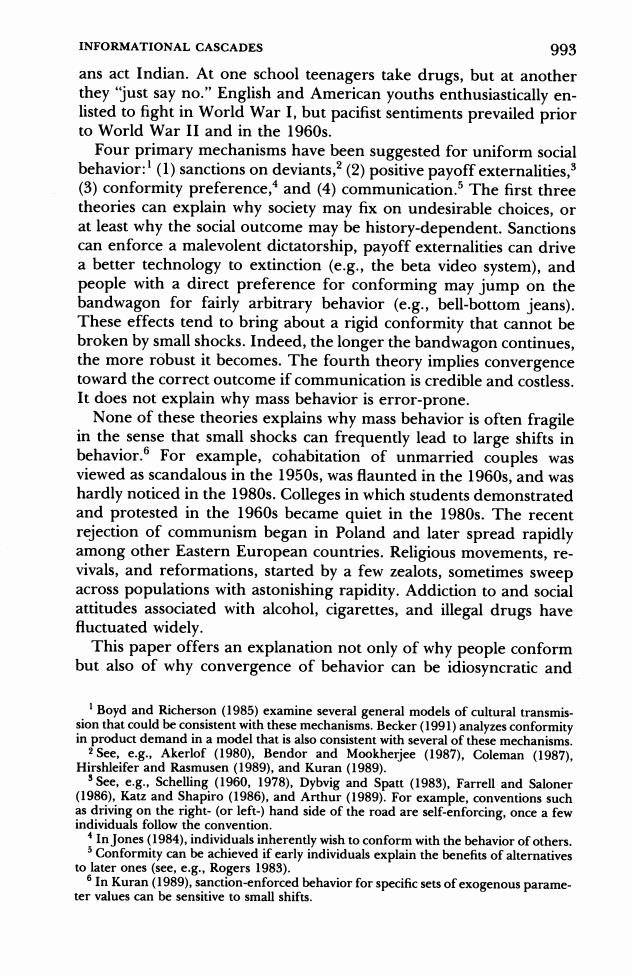正在加载图片...

INFORMATIONAL CASCADES 993 ans act Indian.At one school teenagers take drugs,but at another they"just say no."English and American youths enthusiastically en- listed to fight in World War I,but pacifist sentiments prevailed prior to World War II and in the 1960s. Four primary mechanisms have been suggested for uniform social behavior:(1)sanctions on deviants,?(2)positive payoff externalities,3 (3)conformity preference,4 and(4)communication.5 The first three theories can explain why society may fix on undesirable choices,or at least why the social outcome may be history-dependent.Sanctions can enforce a malevolent dictatorship,payoff externalities can drive a better technology to extinction (e.g.,the beta video system),and people with a direct preference for conforming may jump on the bandwagon for fairly arbitrary behavior (e.g.,bell-bottom jeans). These effects tend to bring about a rigid conformity that cannot be broken by small shocks.Indeed,the longer the bandwagon continues, the more robust it becomes.The fourth theory implies convergence toward the correct outcome if communication is credible and costless. It does not explain why mass behavior is error-prone. None of these theories explains why mass behavior is often fragile in the sense that small shocks can frequently lead to large shifts in behavior.6 For example,cohabitation of unmarried couples was viewed as scandalous in the 1950s,was flaunted in the 1960s,and was hardly noticed in the 1980s.Colleges in which students demonstrated and protested in the 1960s became quiet in the 1980s.The recent rejection of communism began in Poland and later spread rapidly among other Eastern European countries.Religious movements,re- vivals,and reformations,started by a few zealots,sometimes sweep across populations with astonishing rapidity.Addiction to and social attitudes associated with alcohol,cigarettes,and illegal drugs have fluctuated widely. This paper offers an explanation not only of why people conform but also of why convergence of behavior can be idiosyncratic and I Boyd and Richerson(1985)examine several general models of cultural transmis- sion that could be consistent with these mechanisms.Becker(1991)analyzes conformity in product demand in a model that is also consistent with several of these mechanisms See,e.g..Akerlof (1980).Bendor and Mookherjee (1987),Coleman (1987). Hirshleifer and Rasmusen (1989),and Kuran(1989). 3See,e.g..Schelling (1960,1978).Dybvig and Spatt(1983).Farrell and Saloner (1986),Katz and Shapiro (1986),and Arthur (1989).For example,conventions such as driving on the right-(or left-)hand side of the road are self-enforcing,once a few individuals follow the convention. 4 In Jones(1984),individuals inherently wish to conform with the behavior of others. 5 Conformity can be achieved if early individuals explain the benefits of alternatives to later ones (see,e.g.,Rogers 1983). 6 In Kuran(1989),sanction-enforced behavior for specific sets of exogenous parame- ter values can be sensitive to small shifts